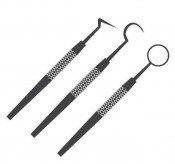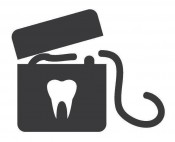Dental Dictionary:
We want you to be informed and feel knowledgeable about your oral health and hygiene, as well as the services available to you. Use this dental dictionary or contact us to learn more!
Abscess
A collection of pus. Usually forms because of infection.
Abutment
A tooth or tooth structure which is responsible for the anchorage of a bridge or a denture.
Amalgam
A silver filling material.
Anesthetic
An agent that causes temporary loss of sensation/feeling.
Anterior
The front position.
Apex
The end of the root.
Asepsis
No micro-organism.
Attrition
Wear of teeth due to activities such as chewing.
Avulsed
An injury that causes a tooth to be completely knocked out of the mouth.
Bitewing
A kind of dental x-ray which is taken with the teeth bite together. The main function of this kind of x-ray is to detect cavities in between teeth and height of bone support.
Bleaching
Whitening of teeth.
Bridge
A prosthesis which is fixed inside the mouth to replace missing teeth.
Bruxism
Teeth grinding.
Calculus
The hard deposits on tooth structure. Also known as tartar.
Canine
The third tooth from the middle of the jaw. There are four of them. They are the longest teeth in humans.
Canker sore
An ulceration with yellow base and red border in mouth. It can be caused by trauma or herpes simplex virus.
Caries
Tooth decay.
Cavity
A hole on the tooth.
Cast
A model of teeth.
Cementation
The process of “gluing” the appliance/prosthesis on the associated area.
Chlorhexidine
An anti-microbial agent. It is available in many forms such as gels and rinses. It is an effective agent in controlling gum diseases.
Clasp
A metal arm extended from a removable partial denture. It helps to hold onto natural tooth structure and thus provide anchorage for the denture.
Cold Sore
An ulcer or blister on lip. A form of herpes simplex.
Composite
White filling.
Cross-Bite
An abnormal bite relationship of upper and lower jaw. The lower teeth/tooth align toward the check/ lip side more than the upper teeth/tooth.
Crown (Porcelain/Plastic/Metal)
A crown is almost like a “cap” on a tooth. It covers the tooth partially or totally above the gum to restore its function and outlook.
Decay
A soft substance caused by the bacterial demineralization of enamel and dentin. An infection within a tooth. Must be treated.
Dentistry
A branch of medicine that involves diagnosis, prevention, and treatment of any disease concerning teeth, oral cavity, and associated structures.
Dentition
The position, type, and number of teeth in upper and lower jaw.
Denture (Immediate, Complete, Partial, Over-denture, Temporary)
An artificial object to replace missing teeth and their neighboring structures. There are many different types of denture to satisfy different treatment requirements and patient preferences.
Denturist
The person who specializes in fabricating dentures. A Denturist is not responsible for making any type of diagnosis or carrying out any other treatment (e.g. removing teeth).
Desensitization
A procedure to reduce the sensitivity of teeth.
Diagnosis
The process of identifying dental disease.
Diastema
The space between two adjacent teeth.
Distal
A direction indication in the mouth. It indicates the direction away from the middle of the jaw.
Edentulous
No teeth.
Endodontics
A department of dentistry involving diagnosis, prevention and treatment of dental pulp (where the nerves and blood vessels are inside the tooth).
Eruption
The process of the tooth appearing in the mouth.
Excision
The action of cutting something off.
Extruded
When a tooth may be pushed partially out of the socket.
Filling
A restoration placed on a tooth to restore its function and appearance.
Flipper
A temporary denture to replace missing teeth during the waiting period for long term treatment.
Floss
A thread/tape that goes in between teeth for cleaning.
Fluoride
A compound of fluorine (an element) which be put in different forms such as water, gels, and rinses to strengthen teeth.
Fluoride Treatment
Teeth treatment with fluoride agents like gel or rinse. It helps to prevent tooth decay.
Fracture
When a cusp of a tooth becomes weakened, a fracture may result. It is possible for the crack to extend further into the root and damage to the pulp is commonplace.
Framework
A metal skeleton of a removable partial denture to support the false teeth and the plastic attachments.
Gingiva
Gum tissue.
Gingivitis
The mildest form of gum disease: inflammation of gum. The earliest sign is bleeding gum.
Hemorrhage
Bleeding
Hemostasis
Stop bleeding.
Impaction
A condition where a tooth is not able to come in normally or is stuck underneath another tooth or bone.
Implant
A device (usually “screw-like”) put in the jaw bone to support a false tooth, a denture or a bridge.
Impression
A mold taken by some jelly-like material loaded on a tray.
Incisal
The cutting edge of front teeth.
Incisor
The four upper and lower front teeth.
Inlay
A restoration (usually gold, composite or ceramics) fabricated in the lab that cements on a tooth like a missing puzzle piece. It helps to restore the normal function and outlook of the tooth.
Interproximal
The space between two adjacent teeth.
Lingual
The side of the tooth towards the tongue.
Mesial
The side of the tooth towards the middle of the jaw.
Molar
The last three upper and lower teeth on both sides of the mouth.
Mouthguard
A device to be worn in the mouth. Depending on the design of it, it prevents injury to teeth and/or jaw during teeth grinding or sport events.
Nightguard (Splint)
A mouthguard which is worn at night time.
Occlusal
The biting surface of the back teeth.
Occlusion
The way how the upper and lower teeth close together.
Onlay
A restoration covers the entire biting surface of a tooth.
Open Bite
The situation where the upper teeth not able to contact the opposing lower teeth.
Orthodontics
A special field in dentistry which involves diagnosis, prevention, and treatment of bite abnormalities or facial irregularities.
Over Bite
The overlap of upper teeth and lower teeth when they close together.
Overhang
The portion of filling material that hangs beyond the border of the cavity.
Palate
The roof of the mouth.
Panoramic Radiograph
An x-ray film used to obtain the wide view of upper and lower jaw and their associated structures.
Perforation
An opening on a tooth or other oral structure.
Periapical
The surrounding of the bottom of the root of a tooth.
Periodontal Disease
Gum disease, ranging from inflammation to serious disease that may result in major damage to the soft tissue and bone that support the teeth.
Periodontics
A specialty of dentistry involves diagnosis, prevention, and treatment of gum (periodontal) disease.
Permanent teeth
Adult’s teeth. The first permanent tooth usually comes in around 6 years old.
Pin
A piece of “nail-like” metal. It usually is used for better retention of a filling.
Plaque
Is a biofilm that develops naturallyon the teeth. It gives rise to tooth decay and can lead to periodontal problems.
Polish
A process to make the tooth or filling or other denture smooth and glossy.
Pontic
The false tooth in a bridge or denture to replace the missing tooth.
Post
A big pin which can be made with different materials such as metal or carbon. Its function usually is to support a big buildup on a tooth.
Posterior
Located at the back.
Pre-authorization
An approval from the particular authority (usually insurance company in dentistry) before any action (treatment) is carried out.
Pre-medication
Medication needing to be taken before treatment.
Premolar
The two teeth located in front of the molar.
Prescription
A written statement (from a doctor to a pharmacist) regarding the type, the amount and direction of the use of a medication for a patient. In dentistry, a prescription can also be a written statement for preparation of an appliance from a dentist to a lab technician.
Primary Teeth
Baby teeth.
Prophylaxis/Prophy
The procedure of teeth polishing. It also means the prevention of diseases.
Prosthesis
An artificial part to replace missing teeth and their associated structures.
Prosthodontics
A specialty of dentistry involving diagnosis, treatment planning, and fabrication of artificial parts to replace missing teeth and their associated structures.
Pulp
The innermost part of a tooth. It contains nerves and blood vessels inside a tooth.
Pulpectomy
The removal of the whole pulp inside a tooth.
Pulpotomy
The removal of the top part of the pulp inside a tooth.
Radiograph
An x-ray picture.
Recall
The regular checkup and teeth cleaning appointment.
Recementation
The process of “gluing” the appliance/prosthesis back on the associated area.
Restoration
An item a dentist uses to restore the normal function of a tooth or an area in the mouth. It can be a filling, a crown, a bridge, etc.
Retainer
A device used for maintaining the position of teeth in the jaw in orthodontic treatment.
Retreatment
The process of repeating the root canal treatment.
Root
The bottom part of tooth. It anchors the tooth to its supporting units.
Root Canal
The canal that runs inside the root of the tooth. It contains the nerves and blood vessels inside the tooth.
Root Canal Treatment
A treatment for the root canal inside the tooth.
Root Planing
The action of cleaning the root area of teeth.
Rubber Dam
A rubber sheet that fits around teeth. It isolates the treatment area from the rest of the oral cavity.
Scaling
The physical removal of deposits from tooth and gingival structure.
Sealant
A thin layer of plastic-like material covering the grooves and pits on a tooth to prevent cavity.
Sedation
The use of medication to calm a patient.
Space Maintainer
An appliance to maintain the space between teeth.
Splint
An appliance or a material to prevent movement of a mobile part.
Tempromandibular Joint (TMJ)
The joint that links the two parts of the jaw.
Torus
An outgrowth of bone. It usually develops on the roof of the mouth or around the premolar area on the lower jaw.
Veneer
A layer of tooth-colored material (can be porcelain, composite, or ceramics) that attaches to the front of the tooth. It is usually used to improve the appearance of the tooth.
Wisdom Tooth
The eighth (also the last) tooth from the middle of the jaw.
Xerostomia
Dry mouth.



